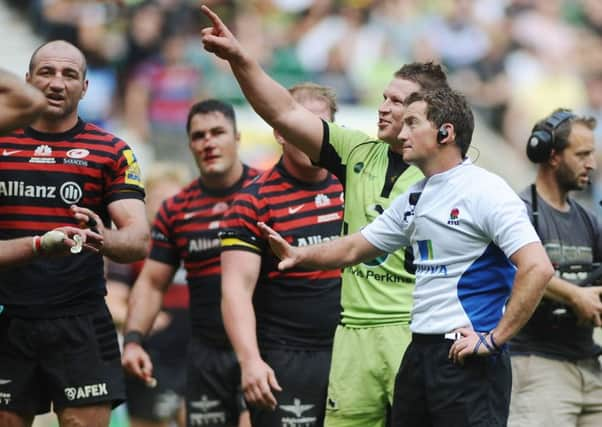Allan Massie: Time wasting TMO replays


Four minutes: Roger Bannister, as we have often been reminded recently, ran a mile in the time the TMO spent studying television pictures. This is crazy. It makes a mockery of the game. Even when he finally reached a conclusion, plenty of people still weren’t sure he had got it right. Common sense suggests that if it takes that long, there’s a lot of doubt, and the try should not be awarded.
The use of television replays is making a nonsense of rugby at the top level. A club match where there are no cameras lasts a bit over 90 minutes, including the half-time break. Professional games where there is a TMO now commonly stretch to two hours or even longer. Players get extended rest periods of two or three minutes while the referee on the field consults the chap sitting before the TV screens. What makes the whole thing even sillier is that there is little evidence to suggest that the TMO’s decisions have removed uncertainty.
Advertisement
Hide AdAdvertisement
Hide AdAs I’ve remarked before – and will doubtless do so again till the authorities see sense, if they ever do – in amateur rugby, referees who are supposedly less able than their professional brethren make the sort of decisions from which the professionals shrink. They trust their own judgement because they have to, and they don’t take four minutes to decide if a try has or has not been scored. The game is the better for it. They make mistakes of course – but then so do the professionals.
Use of the TMO was tolerable – or, in my view, just tolerable – when it was restricted to having him decide whether the ball had been properly grounded and a try scored. Now the referee on the field is entitled to ask him to track back over a number of phases to see if some offence has been committed which will permit him to disallow what looks like a valid try. But if you go back three phases, why not five or fifteen? It’s nonsense, all the more so because the chaps we used to call touch judges are now “assistant referees”, permitted to call attention to misdemeanours. Yet these professional assistants will rarely lift a flag – as touch judges used to – in order to indicate that the ball-carrier has put a foot in touch. They prefer to abdicate authority and wait for the TMO to decide what they should have decided themselves. So what’s the point of them? You might as well go back to having old buffers in blazers running the line. If the referee and his assistants don’t spot a forward pass or a piece of obstruction in the run-up to a try, then the chances are that the pass wasn’t blatantly forward or the obstruction clearly evident, and the try should stand. Better this than holding the game up for lengthy examination which sometimes results in the TMO being unable to happen on the relevant frame. Referees should trust their own judgement.
After all they do so at other key moments of a match. The decision whether to award or not award a penalty at the breakdown is never, so far as I know, referred to the TMO. Thank goodness, one may say. Yet such a decision is often a matter of fine judgement. It may be every bit as debatable as the question of whether the ball has been legally grounded and a try scored. It may have just as much influence on the outcome of the game.
The same is true of scrum penalties. I‘ve never seen a referral to the TMO when a scrum goes down. Not at all, up goes the referee‘s arm, and, no matter how puzzled the supposedly offending prop looks, the penalty is awarded and a goal may be kicked. But if the referee has the courage to trust his own judgement and award a penalty, often in dubious circumstances, why does his courage so often fail when it’s a question of a try? It’s not as if penalties don’t often decide the result.
In short, the game would be better if we dispensed with the TMO and left all decisions to the referee on the field, with whatever help he may get from those designated as his assistants. What’s good enough for Selkirk v Gala ought to be good enough for Scotland v England, or even for the Rugby World Cup. Meanwhile professional rugby is in danger of being a sport in which players hang around for ages waiting for a man in front of a TV screen to scratch his head and eventually arrive at a decision – which may still be wrong. Scrap him.
A far more important question needs to be confronted by the IRB. This is the regulations regarding concussion or suspected concussion. Anyone who doubts the urgency of this question should read an article by Tom English, late of this parish, on the BBC Rugby website. It’s chilling and frightening. Nobody who saw George Smith, in one of last year’s Lions tests, escorted from the field obviously out of it, and return a few minutes later, can doubt that the present regulations or recommendations are hopelessly inadequate. At the very least we ought to return to the protocol that operated in the amateur days: a three-week stand-down. And the decision should be made by doctors independent of the player’s club or country. I suspect we may also be on the point of needing a revision of the tackle law too – but that is matter for another day.